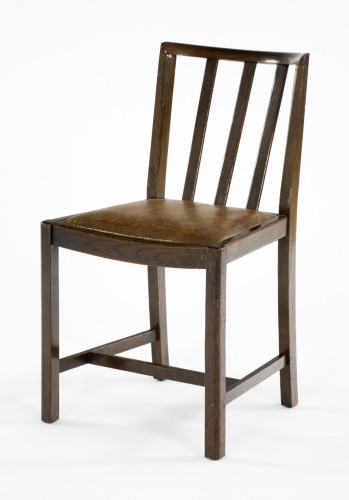F 56-1
Collection
Furniture
Brief description
Dining chair with a stained oak, birch ply, birch and ash frame and drop-in seat upholstered in light brown rexine, model 3A from the 'Chiltern' range of the Utility Furniture Scheme, marked on the seat 'CC41 255', manufactured by Moss Partners (London) Ltd., Enfield, c.1943-1948.
Title
3A
Chiltern
Chiltern
Object name
dining chair
Object number
F 56-1
Production person
Edwin Clinch (designer)
Herbert Cutler (designer)
Herbert Cutler (designer)
Production organisation
Moss Partners (London) Ltd (manufacturer)
Production date
October 1942 (designed)
1943-1948 (manufactured)
1943-1948 (manufactured)
Production place
England (designed)
Enfield (manufactured)
Enfield (manufactured)
Period
Twentieth century (1900-1999)
Material
rexine
oak
birch
plywood
ash
oak
birch
plywood
ash
Technique
joined
upholstered
stained
upholstered
stained
Physical description
This Utility dining chair has a stained oak frame, with a birch ply seat and birch and ash seat rails, and a drop-in seat covered with brown rexine. It has four legs, of square cross-section, braced front to back on each side and once from side to side. The frame of the backrest is curved at the top and has three vertical splats within it. The underside of the drop-in seat is stamped with a Utility mark 'CC41 255'.
Dimensions
Height: 80cm
Width: 46cm
Depth: 50cm
Width: 46cm
Depth: 50cm
Website keywords
seating
dining furniture
dining furniture
Label
Caption for Exploring 20th Century London website:
This chair was made in Enfield by the firm Moss Partner (London) Ltd under the rules of he Utility Furniture Scheme. This scheme governed furniture manufacture during and immediately following the Second World War. It meant that furniture could only be made using a small set of designs approved by the government so that quality and price could be guaranteed. Many people lost their homes and possessions in the Blitz so demand for new furniture was high. Most of the raw materials available had to go towards the war effort so furniture had to be carefully designed to use as little wood as possible. It also had to be easy to make because many skilled furniture makers were fighting in the war or working in munitions factories so unskilled workers were enlisted to make it.
This chair was made in Enfield by the firm Moss Partner (London) Ltd under the rules of he Utility Furniture Scheme. This scheme governed furniture manufacture during and immediately following the Second World War. It meant that furniture could only be made using a small set of designs approved by the government so that quality and price could be guaranteed. Many people lost their homes and possessions in the Blitz so demand for new furniture was high. Most of the raw materials available had to go towards the war effort so furniture had to be carefully designed to use as little wood as possible. It also had to be easy to make because many skilled furniture makers were fighting in the war or working in munitions factories so unskilled workers were enlisted to make it.






